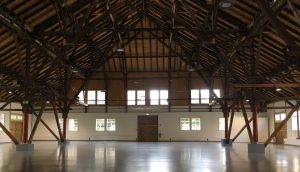40,000 – A Museum of Curiosity
14th Fellbach Triennial for Small Sculpture
June 1–September 29, 2019
Founded in 1980, the Fellbach Triennial for Small Sculpture is one of the most longstanding art exhibitions in Germany and attracts ample public attention. The curator of the 14th edition is Brigitte Franzen. Her concept connects art that is 40,000 years old with contemporary positions. Since its founding in 1980, the Fellbach Triennial has been living up to its name and traced the current impact and significance of small sculpture in contemporary art. With its 14th edition the Triennial drills deep into history for the first time and goes back 40,000 years: some of the oldest works of art in human history were found close to Fellbach, in the Swabian Jura. Small sculptures from the Ice Age which might have been created there but might just as well be relics of early migration.
This edition’s curator Brigitte Franzen takes this heritage as a starting point for a profound exploration into the relationship of art and anthropology as well as into the phenomenon of proportion and scale. Small things are portable, they can easily be carried, and yet at the same time have the ability to render palpable something too large or abstract to grasp. Talismans, totems, fetishes, toys, charms or attributes: small sculptures were—and still are—used frequently close to the human body or in its immediate environment. To this day, artworks have their autonomous place in the history of humankind. Constituting an independent source of knowledge and information they are inextricably linked to other fields of human existence and experience, such as religion, society, science, economy, and the otherworldly, to name just a few. About 150 objects selected with this perspective in mind will be shown, including works by more than 60 artists from over 40 nations. Some works will be newly created, others will reflect the premise and its thematic significance and yet move beyond the given dimension—for example in video works.
The exhibition is thus the first to venture on this balancing act between contemporary art and the origins of art 40,000 years ago, seeking to reveal their shared essence: the interest driving humans, our inherent curiosity to make an image of the world through art objects, grasping them as a means to understand and configure the world—and to survive in it. As the curator puts it, “the idea of art as a reflection and expression of curiosity and a thirst for knowledge is to be the leitmotif of the Triennial 2019—emphasized by the subtitle of the project: ‘The Museum of Curiosity.’” To give the concept the proper architectural frame in the historical space of the Alter Kelter, Brigitte Franzen joins forces with the landscape architects of atelier le balto.
Participating artists
Nevin Aladağ (*1972); Jennifer Allora & Guillermo Calzadilla (*1974 & *1971); Paweł Althamer & Youssouf Dara (*1967 & *1978); Nairy Baghramian (*1971); Taysir Batniji (*1965); Tim Berresheim (*1975); Jenna Bliss (*1984); Katinka Bock (*1976); Matti Braun (*1968); Marcel Broodthaers (*1924 †1976); Mel Chin (*1951); Lygia Clark (*1923 †1988); Alice Creischer / Andreas Siekmann / Stephan Mörsch (*1960 / *1961 / *1974); Attila Csörgö (*1965); Mariechen Danz (*1980); Jeremy Deller (*1966); Simon Denny (*1982); Stephan Dillemuth (*1954); Martin Disler (*1949 †1996); Aleksandra Domanović (*1981); Ayşe Erkmen (*1949); Cerith Wyn Evans (1958); Fabian Feichter (*1986); Andreas Fogarasi (*1977); Axel Foli (*1973); Bruno Gironcoli (*1936 †2010); Nancy Graves (*1939 †1995); Asta Gröting (*1961); Flaka Haliti (*1982); CMUK // Ute Hörner & Mathias Antlfinger (*1964 & *1960); Judith Hopf (*1969); Marguerite Humeau (*1986); Euridice Zaituna Kala (*1987); KAYA (Kerstin Brätsch & Debo Eilers) (*1969 & *1974); Irina Kirchuk (*1983); Norbert Kricke (*1922 †1984); Nikolaus Lang (*1941); Thomas Lanigan-Schmidt (*1948); Sonia Leimer (*1977); Pauline M’Barek (*1979); Ana Mendieta (*1948 †1985); Nishiko (*1981); Katja Novitskova (*1984); Lydia Ourahmane (*1992); Manfred Pernice (*1963); Grayson Perry (*1960); Laure Prouvost (*1978); Michael Rakowitz (*1973); Viola Relle & Raphael Weilguni (*1992 & *1989); Ugo Rondinone (*1964); Martha Rosler (*1943); Eric Sidner (*1985); Vasan Sitthiket (*1957); Michael E. Smith (*1977); Tobias Spichtig (*1982); Studio Ossidiana (Alessandra Covini & Giovanni Bellotti) (*1988 & *1987); Johann Thurfjell (*1970); Anna Uddenberg (*1982); Ma Wen (*1973); Guan Xiao (*1983); Haegue Yang (*1971)
as well as Palaeolithic objects from the Swabian Jura, the Zizenhausen Dance of Death, a Roman Milestone (league stone of the Roman emperor Philipp the Arab, found at Friolzheim, Baden-Württemberg) and castings of cuneiform tablets.


